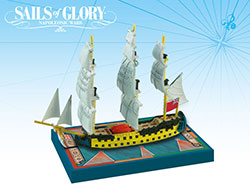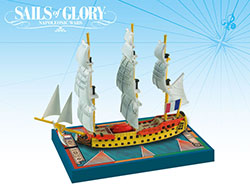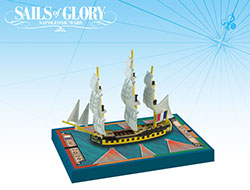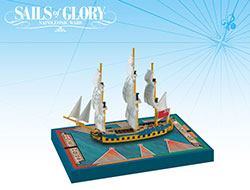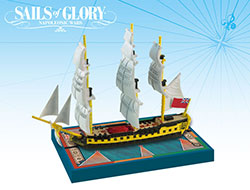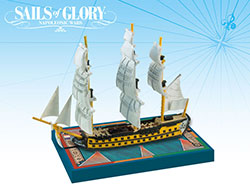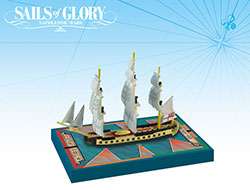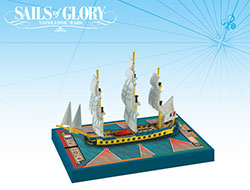Allez, un peu d'histoire ! (En cours de traduction !)
Classe Bellona (Navire de Ligne)
La Classe Bellona est considéré comme un prototype pour les célèbres navires de 74 canons vers la in du 18e siècle.
Les Classes Arrogant, Ramillies, Egmont et Elizabeth furent presque identique en taille, forme et structure, et n'avaient que de légères modifications dans la forme de la coque sous-marine. La Classe Bellona a été réalisée pour un équipage de 550 hommes et était armé de 28 canons de 32 livres dans le pont inférieur, 28 canons de 18 livres sur le pont supérieur et 18 canons de 9 livres sur les ponts de proue et de poupe.
The Elizabeth Class
La Classe Elizabeth comprenait 6 vaisseaux déployés entre 1769 et 1787. L'un d'entre eux fut le HMS Berwick (1775), qui combattit contre les Français à la Bataille d'Ushant (1778) et contre les Hollandais à la Bataille de Dogger Bank (1781). Capturé durant la Révolution Française, il connu plusieurs succès sous le nom Le Berwick et durant les Guerres Napoléoniennes jusqu'ç ce que les Britanniques le recapturèrent lors de la Bataille de Trafalgar.
The HMS Bellona 1760
Le HMS Bellona (1760) fut le premier navire construit de cette Classe, qui comprenait quatre autres navires lancés entre 1760 et 1762. Il eut une longue carrière, servant dans la marine pendant plus de 50 ans, un temps exceptionnellement long pour un de ces vieux navires en bois.
Classe Concorde (Frégates)
The Concorde Class frigates were fifth-rate, 32-guns, fast and maneuverable ships. Three were built at Rochefort from 1777 to 1779 - the Courageuse, the Concorde and the Hermione. They were armed with twenty-six 12-pounder long guns on the main battery and lighter pieces of artillery – four 6-pounder guns on the forecastle and two on the poop deck – and were designed for a crew of 280.
The Hermione 1779
The Hermione 1779 became famous in 1780, when she carried General Lafayette to the United States to bring help and support to the American insurgents in the American Revolutionary War.
The HMS Concorde 1783
The HMS Concorde 1783 was a frigate of the Royal Navy that had previously served in the French Navy under the name Concorde. Captured in February 1783 by HMS Magnificent, it returned to active service under the White Ensign after.
La Classe Téméraire (Navire)
The Téméraire Class ships of the line was and remains the most numerous class of capital ships ever built, with 67 built between 1782 and 1824 for the French navy. These third-rate, 74-guns ships had a designed crew of 700. They were armed with 28 36-Pounder guns in the lower deck, 30 18-Pounder guns in the upperdeck, and 16 8-Pounder guns in the quarterdeck and in the forecastle.
The Commerce de Bordeaux
The Commerce de Bordeaux was funded by a “don des vaisseaux “ (fundraising) donation from Bordeaux. She was laid dawn in 1784 and acquired in 1785. Renamed Timoléon in 1794, she took part in the Battle of the Nile under Captain Louis-Léonce Trullet, and was the last fighting French ship of the battle, exploding after three days, on August 2nd.
The British HMS Impétieux 1796
The British HMS Impétieux 1796 was the former French ship America 1788. The Royal Navy captured her in 1794 at the Battle of the Glorious First of June. She then served with the British under the name HMS Impétuex until she was broken up in 1813. She became the prototype for the Royal Navy America-class ship of the line.
La Classe Amazone (Frégates)
The Amazon Class frigates of 1773 were fifth-rate, 32-guns British ships with a main battery of 12-pounder guns, plus 18-pound carronades and 6-pounder guns in the quarterdeck and in the forecastle. The designed crew was of 220. It comprised 18 ships; the Amazon, Ambuscade and Thetis were launched in 1773; the second batch - Cleopatra, Amphion, Orpheus, Juno, Success, Iphigenia, Andromache, Syren, Iris, Greyhound, Meleager, Castor, Solebay, Terpsichore and Blonde - were launched in 1779 to 1787.
The HMS Cleopatra 1779
The HMS Cleopatra 1779 had a long career in the Royal Navy, seeing service during the Fourth Anglo-Dutch War, and the French Revolutionary and Napoleonic Wars. During the latter wars she fought two notable engagements with larger French opponents.
The HMS Ambuscade 1773
The HMS Ambuscade 1773 was built at Depford and served in the Royal Navy during the American Revolution. It was captured by the French corvette Bayonnaise in December 1798, when blockading Rochefort, and then brought into French service as Embuscade. The frigate was recaptured by the British in May 1803.
(1773)
(1779)
(1796)
(1784)
(1783)
(1779)
